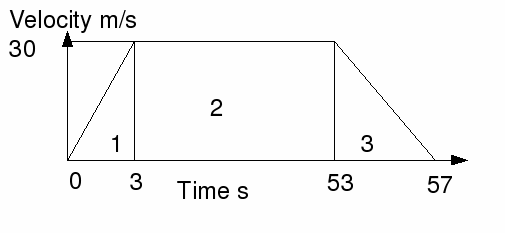There are two very important things to remember about velocity – time graphs.
-
The distance travelled is the area under the graph.
-
The gradient or slope of the graph is equal to the acceleration. If the gradient is negative, then there is a deceleration. We may use the equations
 (1) or some rearrangement of this equation.
(1) or some rearrangement of this equation.
Example. A car starts on a journey. It accelerates for 10 seconds at![]() It then travels at a constant speed for 50 seconds before coming to rest in a further 4 seconds.
It then travels at a constant speed for 50 seconds before coming to rest in a further 4 seconds.
a)Sketch a velocity – time graph.
b)Find the total distance travelled.
c)Find the deceleration when the car is coming to a stop at the end.
d)Find the average speed.

b)Distance travelled = Area under the graph. The graph is a trapezium so use the formula for the area of a trapezium:![]()
c)During the final part of the journey the velocity decreases from 30 to 0 in 4 seconds so![]()
d)![]()
